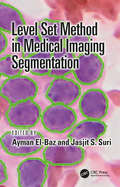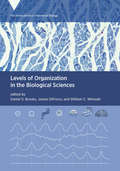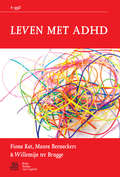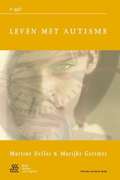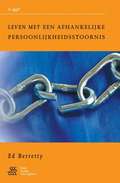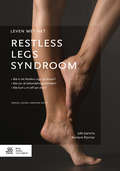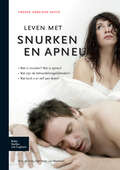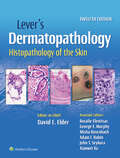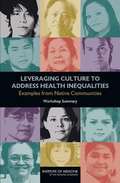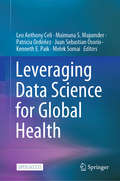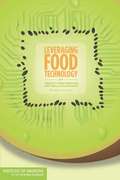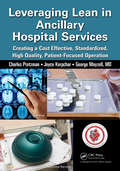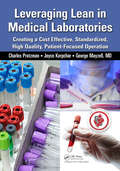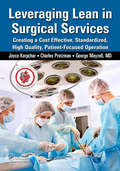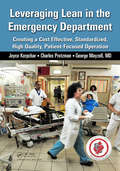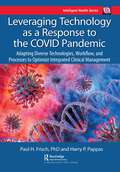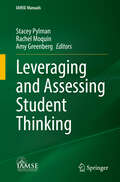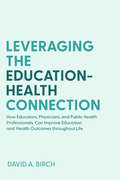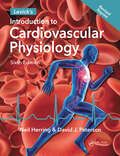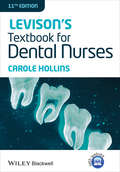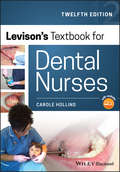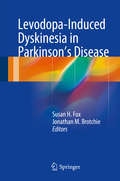- Table View
- List View
Level Set Method in Medical Imaging Segmentation
by Jasjit S. Suri Ayman El-BazLevel set methods are numerical techniques which offer remarkably powerful tools for understanding, analyzing, and computing interface motion in a host of settings. When used for medical imaging analysis and segmentation, the function assigns a label to each pixel or voxel and optimality is defined based on desired imaging properties. This often includes a detection step to extract specific objects via segmentation. This allows for the segmentation and analysis problem to be formulated and solved in a principled way based on well-established mathematical theories. Level set method is a great tool for modeling time varying medical images and enhancement of numerical computations.
Levels of Organization in the Biological Sciences (Vienna Series in Theoretical Biology)
by Daniel S. Brooks, James DiFrisco, and William C. WimsattScientific philosophers examine the nature and significance of levels of organization, a core structural principle in the biological sciences.This volume examines the idea of levels of organization as a distinct object of investigation, considering its merits as a core organizational principle for the scientific image of the natural world. It approaches levels of organization--roughly, the idea that the natural world is segregated into part-whole relationships of increasing spatiotemporal scale and complexity--in terms of its roles in scientific reasoning as a dynamic, open-ended idea capable of performing multiple overlapping functions in distinct empirical settings.The contributors--scientific philosophers with longstanding ties to the biological sciences--discuss topics including the philosophical and scientific contexts for an inquiry into levels; whether the concept can actually deliver on its organizational promises; the role of levels in the development and evolution of complex systems; conditional independence and downward causation; and the extension of the concept into the sociocultural realm. Taken together, the contributions embrace the diverse usages of the term as aspects of the big picture of levels of organization.ContributorsJan Baedke, Robert W. Batterman, Daniel S. Brooks, James DiFrisco, Markus I. Eronen, Carl Gillett, Sara Green, James Griesemer, Alan C. Love, Angela Potochnik, Thomas Reydon, Ilya Tëmkin, Jon Umerez, William C. Wimsatt, James Woodward
Leven met ADHD
by M. Beenackers W. Brugge F. KatOmschrijvingTot voor kort werd ADHD voornamelijk als een aandoening bij kinderen beschouwd. Ook volwassenen kampen met ADHD. Het is een stoornis waarmee je geboren wordt, dat niet zomaar overgaat bij het ouder worden. ADHD kenmerkt zich door aandachtsproblemen, hyperactiviteit en impulsiviteit. Deze kenmerken uiten zich bij iedereen anders en er zijn daarom verschillende typen ADHD. Voor mensen met deze aandoening is het filteren van informatie en het remmen van gedrag moeilijk. Ze lopen hierdoor in nhet dagelijks leven tegen veel problemen aan. In Leven met ADHD geven Maura Beenackers, Fiona Kat en Willemijn ter Brugge antwoord op vragen als: Wat er is met mij aan de hand? Wat betekent ADHD voor mij en mijn omgeving? En: Wat kan ik er zelf aan doen? De auteurs geven praktische tips en bruikbare adviezen over het veranderen van leefgewoonten en het aanleren van nieuwe vaardigheden. Ook de diverse behandelmogelijkheden binnen de GGZ komen aan bod. De auteurs geven praktische tips en bruikbare adviezen over het veranderen van leefgewoonten en het aanleren van nieuwe vaardigheden. Ook de diverse behandelmogelijkheden binnen de GGZ komen aan bod. Leven met ADHD is bedoeld voor mensen met ADHD en hun directe omgeving. Het boek is tevens bruikbaar in de hulpverlening: voor psychologen, psychotherapeuten, huisartsen en maatschappelijk werkers die mensen met ADHD behandelen of begeleiden.
Leven met angst voor ernstige ziektes
by Sjef PeetersVrijwel iedereen maakt zich wel eens zorgen over een pijntje, een vlekje of een slepende vermoeidheid. En dat is maar goed ook. Deze symptomen kunnen namelijk wijzen op een ziekte die om behandeling vraagt. Maar vaak blijkt er helemaal niets aan de hand te zijn. Een geruststellend bericht van de arts is dan voldoende om de angst te laten te verdwijnen, ook als de pijn voortduurt. Wie zich dan toch zorgen blijft maken en niet ophoudt artsen te vragen zich over de klachten te buigen, lijdt waarschijnlijk aan hypochondrie: angst voor het hebben of het krijgen van een ernstige ziekte zonder dat daar medisch gezien aanleiding toe is. Hypochondrie is een veel voorkomende psychische aandoening. Eén tot vijf procent van de bevolking lijdt eraan. Gelukkig zijn de klachten goed te behandelen.
Leven met autisme
by M. Gottmer M. F. DelfosMensen met autisme hebben veel moeite met alledaagse sociale contacten. Dit kan behoorlijk lastig zijn, voor zowel hen zelf als de mensen om hen heen. Het is niet altijd eenvoudig autisme te herkennen, doordat niet iedereen met een autistische stoornis dezelfde autistische kenmerken en in eenzelfde mate vertoont. Dat is jammer, want als je weet dat er autisme in het spel is, zijn er speciale manieren om de communicatie te verbeteren. In Leven met autisme schetsen Martine Delfos en Marijke Gottmer wat autisme betekent voor de mensen zelf en hun omgeving. Zij beschrijven op respectvolle en heldere wijze de kracht en de kwetsbaarheid van mensen met een autistische stoornis. Hierbij worden waardevolle tips gegeven voor het omgaan met de problematische kanten van het leven met autisme. Ook in deze tweede druk is recent onderzoek verwerkt en zijn commentaren van lezers ter harte genomen. Onder andere wordt er op verzoek nog meer aandacht besteed aan het vermijden van moeilijke worden en worden er veel woorden uitgelegd. Vanwege de grote rol van internet en de computer in deze huidige tijd is er informatie over de betekenis van de computer bij autisme opgenomen.
Leven met een Piekerstoornis.
by S. J. Swaen J. Kragten Vogelbescheming Nederland W. A. SterkMensen met een chronische piekerstoornis (gegeneraliseerde angststoornis) leven onder voortdurende hoogspanning. Het overmatige piekeren gaat samen met aanhoudende angst, (over)vermoeidheid of andere lichamelijke en psychische klachten. Meestal is er ook sprake van besluiteloosheid, uitstel- en vermijdingsgedrag. Leven met een piekerstoornis behandelt op heldere en toegankelijke wijze behandelingsmethoden en nieuwe veelbelovende zelfhulptechnieken voor deze angststoornis. Naast informatie over gezonde en ongezonde vormen van angst ligt de focus van dit boek vooral op het geleidelijk zelf leren doorbreken van de piekergewoonte. Getoond wordt welke vaardigheden kunnen bijdragen aan meer evenwicht, zelfacceptatie en mentale rust. Leven met een piekerstoornis verschijnt in de reeks Van A tot ggZ. De boeken uit deze reeks zijn zowel voor de professional als voor de cliënt uiterst bruikbaar om meer inzicht te krijgen in diverse stoornissen
Leven met een afhankelijke persoonlijkheidsstoornis
by S. J. Swaen Vogelbescheming Nederland W. A. Sterk E. W. BerrettyIn dit zelfhulpboek beschrijft auteur Ed Berretty in romanvorm het verhaal van Anne Bloem (48). Naast mevrouw Bloem spelen daarin haar man, haar inwonende dochter van 22 en haar psychotherapeut een belangrijke rol. Aan het einde van elk hoofdstuk wordt de aangereikte kennis in overzichtelijke punten op een rij gezet, aangevuld met bruikbare tips. De lezer krijgt door dit verhaal inzicht in de symptomen van de afhankelijke persoonlijkheidsstoornis en de mogelijkheden om daar iets aan te doen. Mevrouw Bloem kiest in overleg met haar therapeut voor een combinatie van cognitieve therapie en gedragstherapie. Cognitieve therapie maakt je bewust van negatieve basisgedachten, zodat je deze kunt veranderen in neutrale of positieve basisideeën. De levensechte beschrijving van de gesprekken van mevrouw Bloem met haar therapeut en de heldere opdrachten die zij mee naar huis krijgt, zullen voor sommige mensen al voldoende zijn om op eigen kracht van hun persoonlijke afhankelijkheidsstoornis af te komen. Voor anderen kan dit boek de drempel wegnemen om bij de professionele hulpverlening aan te kloppen
Leven met een psychisch zieke ouder
by S. Van GamerenNederland telt meer dan 850. 000 ouders met een psychische stoornis. Zo'n ziekte heeft uiteraard invloed op de jeugd van hun kinderen. Een groot deel van deze kinderen groeit desondanks op tot evenwichtige volwassenen, terwijl een ander deel vroeg of laat in het leven te maken krijgt met de uiteenlopende gevolgen van hun jeugdervaringen. In dit boek komen de factoren die hierbij een rol spelen ruimschoots aan bod. In Leven met een psychisch zieke ouder laat gezondheidspsycholoog Sandra van Gameren zien hoe je deze kinderen - ook wel aangeduid met 'koppers' (kopp kinderen van ouders met psychiatrische problemen) - kunt helpen hun veerkracht te behouden. Aan de hand van een tiental ervaringsdeskundigen weet zij een goed beeld te schetsen van de realiteit van een kopp-jeugd en de uitwerking die zo'n jeugd kan hebben op de rest van iemands volwassen leven. Het boek laat zien hoe, naast de zieke en gezonde ouder, andere volwassenen een kopper tijdens zijn/haar jeugd kunnen bijstaan en er zo voor kunnen zorgen dat het kind een manier vindt om met de thuissituatie om te gaan.
Leven met het restless legs syndroom
by Joke Jaarsma Roselyne M. Rijsman"In dit boek komen de diverse aspecten van RLS aan de orde. Wat is de oorzaak, hoe stel je de diagnose, hoe vaak en bij wie komt het voor, kan RLS behandeld of genezen worden, wat kun je in eerste instantie zelf doen, wat betekent het voor je omgeving? Duidelijk is dat RLS niet alleen het leven van de patiënt zelf ingrijpend kan verstoren, maar ook dat van de naaste omgeving. Het boek biedt dan ook handvatten om de kwaliteit van leven te verbeteren." Naast het informeren van patiënten over RLS is dit boek ook geschreven om behandelaars en begeleiders informatie te bieden waarmee zij hun behandeling en benadering van de patiënt kunnen optimaliseren.
Leven met snurken en apneu
by Piet Heijn Mechelen Nico De VriesNieuwe herziene editie van Leven met snurken. Geheel geactualiseerd en aangevuld met de nieuwste ontwikkelingen.
Lever's Dermatopathology: Histopathology of the Skin
by Misha Rosenbach Adam I. Rubin David E. Elder Rosalie Elenitsas George F. Murphy John T. Seykora Xiaowei XuUsed by generations of physicians who encounter patients with dermatological diseases, Lever’s Dermatopathology: Histopathology of the Skin comprehensively covers skin disease in which histopathology plays an important role in diagnosis. The updated 12th Edition, edited by Drs. David E. Elder, Rosalie Elenitsas, George F. Murphy, Misha Rosenbach, Adam I. Rubin, John T. Seykora, and Xiaowei Xu, maintains the proven, clinicopathologic classification of cutaneous disease while incorporating a “primer” on pattern-algorithm diagnosis. It features larger images throughout, as well as thoroughly revised content with new diseases and new information on pathophysiology and molecular pathogenesis—all in an easy-to-navigate, highly readable format.
Leveraging Culture to Address Health Inequalities
by Institute of Medicine Steve Olson Karen M. Anderson Board on Population Health and Public Health Practice Roundtable on the Promotion of Health Equity and the Elimination of Health DisparitiesLeveraging Culture to Address Health Inequalities: Examples from Native Communities is the summary of a workshop convened in November 2012 by the Roundtable on the Promotion of Health Equity and the Elimination of Health Disparities of the Institute of Medicine. The workshop brought together more than 100 health care providers, policy makers, program administrators, researchers, and Native advocates to discuss the sizable health inequities affecting Native American, Alaska Native, First Nation, and Pacific Islander populations and the potential role of culture in helping to reduce those inequities. This report summarizes the presentations and discussion of the workshop and includes case studies that examine programs aimed at diabetes prevention and management and cancer prevention and treatment programs. In Native American tradition, the medicine wheel encompasses four different components of health: physical, emotional, mental, and spiritual. Health and well-being require balance within and among all four components. Thus, whether someone remains healthy depends as much on what happens around that person as on what happens within. Leveraging Culture to Address Health Inequalities addresses the broad role of culture in contributing to and ameliorating health inequities.
Leveraging Data Science for Global Health
by Maimuna S. Majumder Leo Anthony Celi Patricia Ordóñez Juan Sebastian Osorio Kenneth E. Paik Melek SomaiThis open access book explores ways to leverage information technology and machine learning to combat disease and promote health, especially in resource-constrained settings. It focuses on digital disease surveillance through the application of machine learning to non-traditional data sources. Developing countries are uniquely prone to large-scale emerging infectious disease outbreaks due to disruption of ecosystems, civil unrest, and poor healthcare infrastructure – and without comprehensive surveillance, delays in outbreak identification, resource deployment, and case management can be catastrophic. In combination with context-informed analytics, students will learn how non-traditional digital disease data sources – including news media, social media, Google Trends, and Google Street View – can fill critical knowledge gaps and help inform on-the-ground decision-making when formal surveillance systems are insufficient.
Leveraging Food Technology for Obesity Prevention and Reduction Effort: Workshop Summary
by The National Academy of SciencesObesity is a major public health challenge. More than one-third of the U. S. adult population is considered obese, a figure that has more than doubled since the mid-1970s. Among children, obesity rates have more than tripled over the same period. Not only is obesity associated with numerous medical complications, but it incurs significant economic cost. At its simplest, obesity is a result of an energy imbalance, with obese (and overweight) people consuming more energy (calories) than they are expending. During the last 10-20 years, behavioral scientists have made significant progress toward building an evidence base for understanding what drives energy imbalance in overweight and obese individuals. Meanwhile, food scientists have been tapping into this growing evidence base to improve existing technologies and create new technologies that can be applied to alter the food supply in ways that reduce the obesity burden on the American population. Leveraging Food Technology for Obesity Prevention and Reduction Effort examines the complexity of human eating behavior and explores ways in which the food industry can continue to leverage modern food processing technologies to influence energy intake. The report also examines the opportunities and challenges of altering the food supply--both at home and outside the home--and outlines lessons learned, best practices, and next steps.
Leveraging Lean in Ancillary Hospital Services: Creating a Cost Effective, Standardized, High Quality, Patient-Focused Operation
by Charles Protzman Joyce Kerpchar George MayzellThis book is part of a series of titles that are a spin-off of the Shingo Prize-winning book Leveraging Lean in Healthcare: Transforming Your Enterprise into a High Quality Patient Care Delivery System. Each book in the series focuses on a specific aspect of healthcare that has demonstrated significant process and quality improvements after a Lean
Leveraging Lean in Medical Laboratories: Creating a Cost Effective, Standardized, High Quality, Patient-Focused Operation
by Charles Protzman Joyce Kerpchar George MayzellThis book is part of a series of titles that are a spin-off of the Shingo Prize-winning book Leveraging Lean in Healthcare: Transforming Your Enterprise into a High Quality Patient Care Delivery System. Each book in the series focuses on a specific aspect of healthcare that has demonstrated significant process and quality improvements after a Lean
Leveraging Lean in Surgical Services: Creating a Cost Effective, Standardized, High Quality, Patient-Focused Operation
by Charles Protzman Joyce Kerpchar George MayzellThis book is part of a series of titles that are a spin-off of the Shingo Prize-winning book Leveraging Lean in Healthcare: Transforming Your Enterprise into a High Quality Patient Care Delivery System. Each book in the series focuses on a specific aspect of healthcare that has demonstrated significant process and quality improvements after a Lean
Leveraging Lean in the Emergency Department: Creating a Cost Effective, Standardized, High Quality, Patient-Focused Operation
by Charles Protzman Joyce Kerpchar George MayzellThis book is part of a series of titles that are a spin-off of the Shingo Prize-winning book Leveraging Lean in Healthcare: Transforming Your Enterprise into a High Quality Patient Care Delivery System. Each book in the series focuses on a specific aspect of healthcare that has demonstrated significant process and quality improvements after a Lean
Leveraging Technology as a Response to the COVID Pandemic: Adapting Diverse Technologies, Workflow, and Processes to Optimize Integrated Clinical Management (Intelligent Health Series)
by Harry P. Pappas Paul H. FrischIn 2019 the world was struck with the Coronavirus (COVID-19) infecting major portions of the world’s population. There were no vaccines or treatments available to help mitigate the disease or offer a cure. The world's health systems were inundated with massive numbers of patients with varying ranges of symptoms, acuity, and levels of criticality. The world's healthcare organizations soon found themselves in an unmanageable situation, directly impacting the ability to manage patients across the entire healthcare environment. Most healthcare institutions had plans for emergency preparedness and procedures to deal with temporary crises, none of which were effective against the impact of COVID-19. COVID-19 was a highly contagious disease, resulting in high volumes of admissions with long lengths of stay. The virus quickly overwhelmed institutions with large patient volumes, resulting in shortages of patient beds, medical equipment, personal protective devices, cleaning agents, and other critical supplies. Hospital operations were further impacted by staff shortages due to exposure, resulting contagion, the shutdown of transit systems, and responsibilities at home due to school and business closures. This timely and important book describes the impact on the hospital ability to provide patient care and how healthcare institutions leveraged diverse technology solutions to combat the impact of COVID-19 on providing patient care. The authors also discuss implementation of these technology solutions and the many lessons learned of how healthcare institutions can enhance their emergency preparedness in the future from the COVID experience. The authors would like to acknowledge, thank, and dedicate this book to the hundreds of thousands of healthcare workers around the world who spent countless hours and put their own lives and families lives at risk to help patients though this pandemic.
Leveraging and Assessing Student Thinking (IAMSE Manuals)
by Amy Greenberg Stacey Pylman Rachel MoquinThis book is a compilation of teaching theories and strategies for eliciting and interpreting student thinking to adapt to educational settings. Medical education is no longer about simply providing students with knowledge, as it was in Flexner’s day. Modern medical education is focused on shaping how students understand, define, and move the practice of medicine forward. Modern medical schools focus on building student’s ability to reason clinically and develop their own identity as professionals while integrating those pieces of their identity with their emerging content knowledge. This level of high-quality education requires medical educators to understand their learners and see their learners as more than repositories for knowledge. A medical educator must understand who the learner is, what the learner already knows, and what misunderstandings the learner has. Hence, educators must learn to be skilled not simply at conveying information, but rather at eliciting student thinking and understanding to discern what and how to best teach the learner. Faculty often think of teaching this way as complex and time-consuming. However, in this manual we reveal that once the theoretical underpinnings of why leveraging and assessing student thinking matters are understood, educators can enact the theory by building specific teaching skills. This manual is written by authors steeped in educational theory and with a background in teacher education. Other manuals and book chapters have looked at active learning and rubrics which are part of learner-centered instruction. This manual is the first of its kind to help medical educators practice what it means to teach in a learner-centered way by leveraging student thinking. The manual is written using educational theory and literature, includes vignettes for illustrative purpose, and provides practical steps in enacting strategies to elicit student thinking. In the first section of this manual, we define the practices of eliciting and interpreting student thinking and explain why student thinking matters, introduce readers to gradual release theories of learning, and showcase the benefits of using students’ experiences, background, and prior knowledge. In the second section of the manual, we explain in further detail how to leverage and assess student thinking. We describe, illustrate with vignettes, and provide step by step guides on the skills of questioning, giving feedback, debriefing clinical experiences, analyzing student work, and assessing student thinking and understanding in the medical education context.
Leveraging the Education-Health Connection: How Educators, Physicians, And Public Health Professionals Can Improve Education And Health Outcomes Throughout Life
by David A. BirchLevick's Introduction to Cardiovascular Physiology
by Neil Herring David J. PatersonA sound knowledge of cardiovascular physiology is fundamental to understanding cardiovascular disease, exercise performance and may other aspects of human physiology. Cardiovascular physiology is a major component of all undergraduate courses in physiology, biomedical science and medicine, and this popular introduction to the subject is intended primarily for these students. A key feature of this sixth edition is how state-of-the-art technology is applied to understanding cardiovascular function in health and disease. Thus the text is also well suited to graduate study programmes in medicine and physiological sciences.
Levison's Textbook for Dental Nurses
by Carole HollinsIn this brand-new 11th edition of the original, best-selling book, Levison's Textbook for Dental Nurses gives you the same great comprehensive coverage of everything students preparing for their dental nurse qualification need to know, and also includes for the first time:A new look and feel, packed with illustrations and diagrams to make visual learning easyKey Learning Points in every chapter help you master essential informationAn accompanying website designed to help you test your knowledge with self-assessment exercises, case-studies and downloadable imagesFully in line with the most recent developments in dental nursing practice and education, Levison's Textbook for Dental Nurses is the only dental nursing book written specifically to cater to the new NEBDN Diploma in Dental Nursing.Written by Carole Hollins, the former Chair of the National Examining Board for Dental Nurses, the new edition of Levison's classic textbook is the only companion you need to get you through to qualification as a successful and accomplished dental nurse.
Levison's Textbook for Dental Nurses
by Carole HollinsA fully updated edition of the best-selling textbook for students studying for their dental nurse qualification Levison’s Textbook for Dental Nurses continues to be an indispensable resource written specifically for those undertaking the NEBDN National Diploma in Dental Nursing. This new edition provides in-depth coverage in many areas, such as the structure of the dental profession; an update of the current, available NHS dental services; information on extended duties for dental nurses; legal and ethical issues; health and safety including COSHH and waste disposal legislation updates; general anatomy and physiology; and medical emergencies. New edition of a classic textbook, fully in line with the most recent developments in dental nursing practice and education Caters especially for the NEBDN National Diploma in Dental Nursing Outlines the latest GDC standards for dental nurses Key Learning Points in every chapter to help readers master essential information Packed with illustrations and diagrams to assist with aiding comprehension, this student-friendly text is ideal for dental nurses studying for the NEBDN National Diploma in Dental Nursing. It will also be of great benefit to dental nurses studying for the City & Guilds Diploma in Dental Nursing, Level 3.
Levodopa-Induced Dyskinesia in Parkinson's Disease
by Susan H. Fox Jonathan M. BrotchieThis book aims to provide a single reference source on levodopa-induced dyskinesias (LID) from 'bench to bedside'. Initial chapters review the clinical features and phenomenology of LID with video examples; epidemiology and genetic risk factors for LID are covered as a background to understanding risk factors for developing LID. The following chapters cover the latest preclinical studies aiming to understand the pathophysiology of LID at the cellular, neurochemical, neurophysiological and circuitry level with detailed discussion of mechanisms and future directions to take the field forward; clinical studies from phase II to phase IV; on going RCTs in LID and evidence-based medicine reviews of treatment options. Levodopa-Induced Dyskinesia in Parkinson's Disease is aimed at an international audience of movement disorder neurologists; neuroscientists; trainees and graduate and post-graduate students.
